
This text is a free resource by Thomas Payne. It provides basic information to first year students. Visit: http://faculty.wartburg.edu/payne/
- Subject:
- Fine Arts
- Visual Art
- Material Type:
- Textbook
- Author:
- Thomas Payne
- Date Added:
- 08/18/2021

This text is a free resource by Thomas Payne. It provides basic information to first year students. Visit: http://faculty.wartburg.edu/payne/

Students will learn about the jazz singer Billie Holiday and the sociohistorical context in which she performed. They will learn how discriminatory statutes (called Jim Crow laws) affected daily life. They will also analyze how movement is created in photographs and the effect of a photographer's point of view on composition. Finally, students will photograph a musician, paying attention to what can be communicated through point of view.

Students will learn about axial movements and locomotor movements by discussing dancers depicted in a drawing and photograph. They will then practice combining axial and locomotor movements. They will describe how artists depict a dancer's motion in drawing and photography. They will also analyze how an artist creates movement and emphasis through contrast, composition, and leading lines, and then experiment with photography to capture motion in dance.
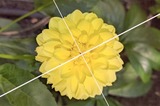
Learn about many ways to combine art and science as we observe the world around us. We often think of scientists as methodical and precise, and artists as free-willed, impulsive creators. But did you know that some art has science packed right into it? And that artists throughout history have helped scientists conduct their work? Learn about the photography of Berenice Abbott who documented the changing New York skyline with photographs of architecture and urban design of the 1930s, and science interpretation in the 1940s to 1960s. Learn how to use the sun to air dry your salt dough creations and explore papier-mâché.

Advanced-level students will write narratives from the perspective of slaves depicted in rare photographs, and then create a print depicting a moment from the narratives.
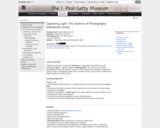
Students create and use pinhole cameras to understand how artists use and manipulate light to capture images in photographs. They shoot and develop photographs made with pinhole cameras. They compare and contrast a nineteenth-century image, photographs taken with a pinhole camera, and pictures created with a digital camera or camera phone.
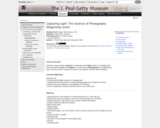
Students create pinhole cameras to understand that light travels in a straight path. They describe the lines and shapes in a nineteenth-century photograph of a building and then use their pinhole cameras to trace the architecture of their school building.
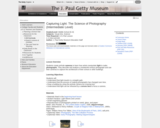
Students create pinhole cameras to learn how artists manipulate light to make photographs. They describe and analyze a nineteenth-century photograph and use their cameras to capture the architecture of their school or other buildings.

Students will research how the development of the atomic bomb affected people in World War II, participate in a debate about the bomb's use, and investigate how it has affected people's lives since 1945.

Photography, as a nonverbal language, allows students to increase their visual perception and provides a medium for creative expression. The history of photography will be evaluated in the context of historical, social, cultural and artistic developments. Students learn to understand the artistic qualities of the photographic medium while acquiring the techniques for utilizing photography for expressive purposes. Instruction includes studio and field techniques, photojournalism, fashion photography, and commercial, portrait, scientific, nature, wildlife and sports photography. In producing their own works and by studying the photographs of others, students will develop a base for making informed aesthetic judgments. Integrated throughout the course are career preparation standards which include basic academic skills, communication, interpersonal skills, problem solving, workplace safety, and technology and employment literacy.
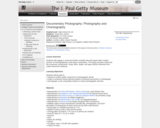
Students will engage in visual and written activities that will support their creative process of choreographing a solo dance composition. The lesson includes motifs and the movement components -- body, effort, shape, and space (BESS elements from Laban Movement Analysis).
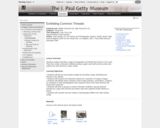
Students analyze Dorothea Lange's photographs and identify key themes in her work. They then create a thematic exhibition pairing Lange's work with work by artists who explore the same themes in other media.
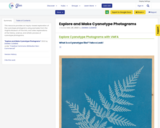
This resource provides an inquiry-based exploration of the cyanotype photograms using examples from the Virginia Museum of Fine Arts, and video explanations of the history, science, and artistic process of cyanotype photograms.
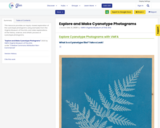
This resource provides an inquiry-based exploration of the cyanotype photograms using examples from the Virginia Museum of Fine Arts, and video explanations of the history, science, and artistic process of cyanotype photograms.
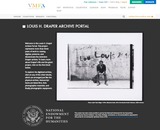
This resource presents a variety of digital resources hosted by Virginia Museum of Fine Arts that students can use to explore the life and work of renowned African-American photographer Louis Draper.

Students will learn the basic tools for analyzing images using description, reflection, and formal analysis.
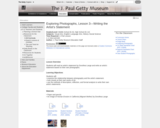
Students will read an artist's statement by Dorothea Lange and write an artist's statement based on their own photographs.

Students will create a timeline outlining various groups' struggles for equal opportunity and create a 30-second radio or video public service announcement (PSA).

Students will analyze shapes and patterns in a photograph, hear stories about people who were forced to move to internment camps because of their ethnicity, and create drawings that tell a story about a young girl's life in an internment camp.

Students will read primary source documents about the U.S. internment of Japanese Americans following the bombing of Pearl Harbor and will examine various versions of a photograph by Dorothea Lange and explore how cropping can evoke different effects.